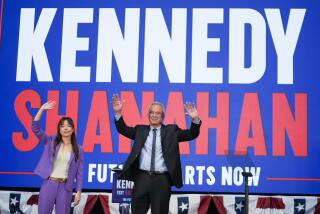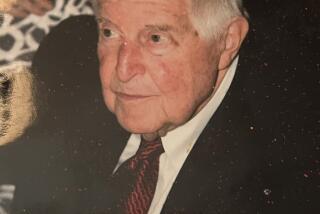Roger Kennedy dies at 85; former National Park Service director
One day deep in the administration of George W. Bush — a time of tumult among environmentalists and conservationists — Roger Kennedy found himself shaking his head and sighing. The Endangered Species Act was in the cross hairs of a Republican Congress and his beloved National Park Service, which Kennedy directed from 1993 to 1997, was under assault.
Kennedy was disgusted by the partisan bickering. When had stewardship of the environment become a political football, he asked, posing a rhetorical question to a reporter. Don’t they know that much of the landmark environmental legislation was passed when a Republican, Richard Nixon, was in the White House?
“In those days there was more civility; members of Congress may have disagreed, but they went out to dinner together,” Kennedy said. “One guy would come up with the beginnings of the Clean Water Act or the Clean Air Act and go to another senator and say: ‘We need to pass this. It’s the right thing to do.’ And they would pass it, and Nixon would sign it. Different times.”
Kennedy often invoked the spirit of bipartisanship in his various roles as passionate defender of all things American — its history, its landscapes and its diverse population.
Kennedy, 85, died of melanoma Friday at his home in Rockville, Md.
“Roger Kennedy was a Renaissance man,” said National Park Service Director Jonathan Jarvis.
Indeed, Kennedy packed a score of careers into one lifetime.
He was a Washington correspondent and covered the Supreme Court for NBC, and wrote and presented documentaries for PBS as well as two television series for the Discovery Channel. Kennedy also was a bank chairman, failed political candidate, vice president of the University of Minnesota and an executive with the Ford Foundation.
He served six different presidents, and in the 1950s was a special assistant to the U.S. attorney general, the secretary of Health, Education and Welfare and the secretary of Labor. He wrote more than a dozen books.
Kennedy was a genial man, a keen storyteller and a valuable asset for reporters seeking thoughts on an array of topics. His unfailing courtesy and impeccable manners tempered a lifelong knack for starting trouble and cutting against the grain.
It was as director of the Smithsonian’s National Museum of American History that Kennedy left an indelible mark. He began his 13-year tenure in 1979 and sought to cast open the doors on the stuffy, traditional institution often referred to as “America’s attic.”
Kennedy signaled his intention to shake things up when he ordered a name change, dropping the imposing-sounding Museum of History and Technology. He then proceeded to raise the ire of art world purists when he championed exhibitions of popular culture and advocated for contemporary shows designed to draw a more diverse crowd to the museum.
His offerings spanned the mass market — displaying Dorothy’s red slippers from the movie “The Wizard of Oz” — to the socially provocative — a painful look at the internment of Japanese Americans during World War II.
Times were equally rocky when President Clinton tapped Kennedy to lead the park service. It was a time of downsizing for the federal government, and Kennedy presided over painful cuts to the agency.
Kennedy bristled when called before Congress to assign a value to park structures and landmarks for corporate bidders. He disapproved of such ideas, arguing that the national parks were no less repositories of American cultural and historic treasures than museums and ought not to be sold.
He maintained a solidarity with park service employees, unusual in an executive, and took to wearing the agency’s gray and green uniform as his daily attire.
Kennedy spoke out against an effort to privatize federal workers — including park service employees — telling The Times in 2003, “This is about respect for professionals. It is about a recognition that people spend a lifetime learning their profession and how to resist pressures — political or commercial — in the public interest. The public understands that parks are not parking lots — they are places that require a high degree of professional skill to manage. Not just anyone can do it.”
During his tenure, the agency added eight parks, including the Mojave National Preserve, and greatly expanded the acreage of Joshua Tree and Death Valley, reclassifying both as national parks from earlier status as national monuments.
Roger George Kennedy was born Aug. 3, 1926, in St. Paul, Minn., into an outdoor-loving family. The family business was the Kennedy Brothers Arms Co., a gun shop and expedition outfitter. The young Kennedy canoed, hiked and guided expeditions in the Boundary Waters of the Upper Midwest.
After serving in the Navy during World War II, he graduated from Yale University in 1949 and from the University of Minnesota Law School in 1952. That year, he lost a congressional race against the incumbent, Minnesota Democrat Eugene McCarthy.
Survivors include his wife of 53 years, Frances Hefren Kennedy; a daughter, Ruth Kennedy Sudduth of Stow, Mass.; and a brother.
More to Read
Start your day right
Sign up for Essential California for the L.A. Times biggest news, features and recommendations in your inbox six days a week.
You may occasionally receive promotional content from the Los Angeles Times.





















































